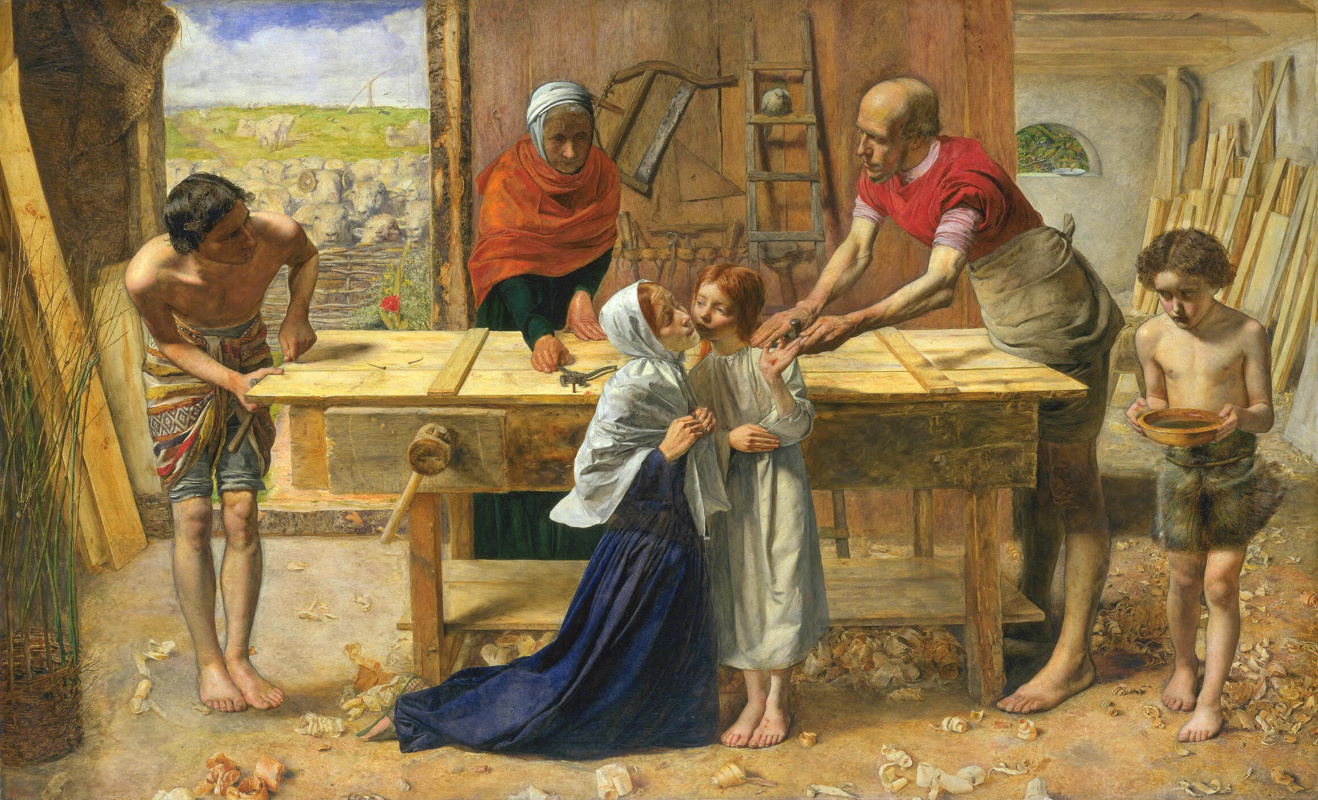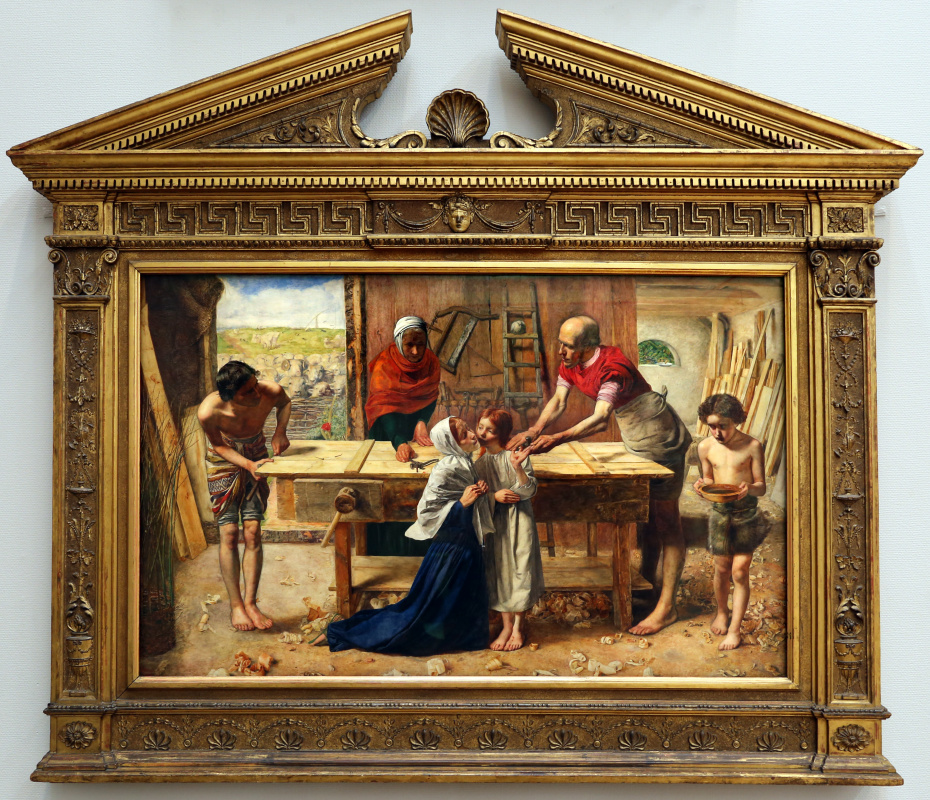log in
Enter site
Login to use Arthive functionality to the maximum
Christ in his parents' house
John Everett Millais • Painting, 1850, 86.4×139.7 cm
Description of the artwork «Christ in his parents' house»
At the annual exhibition of the Royal Academy in London in 1850, there was a real scandal - 21-year-old artist John Everett Millais presented the painting "Christ in the House of His Parents." Cynical, blasphemous, defiant and low. There was a painting in the same room Holman hunt "Convert British family, harboring a missionary from the pursuit of druids". She got it too, but the most fierce disputes were still around Millet's work - if Hunt took up the history of early Christianity, then the upstart Millet swung at the history of the Holy Family itself. Charles Dickens became the harshest and wittiest critic of the Pre-Raphaelites - he published the essay “Old lamps instead of new ones” in the magazine “Home Reading”. And blew the picture to pieces:
“Before us is a carpentry workshop. In the foreground there is a disgusting red-haired boy in a nightgown, in tears, with a twisted neck. It seems that he was playing with his friends somewhere in the gutter and got a stick in his hand, and now he complains to a kneeling woman, so unthinkably ugly, that they would stare at her with horror in the most low-grade French pub or English beer - if, of course, assume that a person with such a coiled neck can live for even a minute. Nearby, two almost bare carpenters, a master and an apprentice, are engaged in their work - worthy companions of this pleasant person. Another boy, in which something human is still dawning, carries a bowl with water, and no one pays attention to an old woman with a yellowed face who apparently went to the tobacco shop and was mistaken by the door, and now she can’t wait for her to be weighed down half an ounce of your favorite snuff. Everything that can be portrayed as ugly in a human face, body, or posture is also depicted. Half-dressed types like these carpenters can be seen in any hospital where dirty drunks with varicose ulcers end up, and their bare feet seem to have flashed here all the way from the slums of St. Giles. ”
Dickens is at the peak of fame, he is adored, he is listened to, he is believed. Moreover, the blasphemous interpretation of the life of the young Christ is already so obvious - Millet took it and presented it as if the sacred scene were taking place around the corner of his own house.
John Everett Millet did paint a picture in the London carpentry workshop, where it was easy to find mountains of chips, a rough desktop, the necessary set of tools. The carpenter himself, the master of the mattress, the father, the cousin, the daughter-in-law and the son of a friend posed for him — no professional models. The artist needed to buy a pair of sheep heads from a butcher in order to accurately and truthfully write the herd outside the workshop walls. The main goal, idea, mission is to write, without departing a single step from what you see, from nature and truth. For the middle of the XIX century in Victorian England, such a presentation of the classical biblical scene was too straightforward and radical.
The general panic and feeling of an inexplicable threat were so strong that Queen Victoria herself ordered that the picture be removed from the exhibition and brought to her for examination. Something inexorably changed in the art of England with this work, there was an irreversible turning point, after which reliable pictorial soil would collapse, trampled and strengthened over the centuries. This stable soil was safe and familiar, but, unfortunately, absolutely barren and lifeless: from year to year, traditionally idealized heroes appeared in exhibitions of the Royal Academy in a relatively beautiful landscape. And then a boy in a shirt, dirty heels, muscular arms, wrinkled weathered faces, a doorway from a barely hewn log, trash on the floor.
It is hard to believe this, but Millet found a defender seriously competing in terms of influencing public opinion with the author of the Post-Death Notes of the Pickwick Club. It was John Ruskin, art critic and writer, thanks to whom Millet will be the youngest member of the Royal Academy after 3 years.
Author: Anna Sidelnikova
“Before us is a carpentry workshop. In the foreground there is a disgusting red-haired boy in a nightgown, in tears, with a twisted neck. It seems that he was playing with his friends somewhere in the gutter and got a stick in his hand, and now he complains to a kneeling woman, so unthinkably ugly, that they would stare at her with horror in the most low-grade French pub or English beer - if, of course, assume that a person with such a coiled neck can live for even a minute. Nearby, two almost bare carpenters, a master and an apprentice, are engaged in their work - worthy companions of this pleasant person. Another boy, in which something human is still dawning, carries a bowl with water, and no one pays attention to an old woman with a yellowed face who apparently went to the tobacco shop and was mistaken by the door, and now she can’t wait for her to be weighed down half an ounce of your favorite snuff. Everything that can be portrayed as ugly in a human face, body, or posture is also depicted. Half-dressed types like these carpenters can be seen in any hospital where dirty drunks with varicose ulcers end up, and their bare feet seem to have flashed here all the way from the slums of St. Giles. ”
Dickens is at the peak of fame, he is adored, he is listened to, he is believed. Moreover, the blasphemous interpretation of the life of the young Christ is already so obvious - Millet took it and presented it as if the sacred scene were taking place around the corner of his own house.
John Everett Millet did paint a picture in the London carpentry workshop, where it was easy to find mountains of chips, a rough desktop, the necessary set of tools. The carpenter himself, the master of the mattress, the father, the cousin, the daughter-in-law and the son of a friend posed for him — no professional models. The artist needed to buy a pair of sheep heads from a butcher in order to accurately and truthfully write the herd outside the workshop walls. The main goal, idea, mission is to write, without departing a single step from what you see, from nature and truth. For the middle of the XIX century in Victorian England, such a presentation of the classical biblical scene was too straightforward and radical.
The general panic and feeling of an inexplicable threat were so strong that Queen Victoria herself ordered that the picture be removed from the exhibition and brought to her for examination. Something inexorably changed in the art of England with this work, there was an irreversible turning point, after which reliable pictorial soil would collapse, trampled and strengthened over the centuries. This stable soil was safe and familiar, but, unfortunately, absolutely barren and lifeless: from year to year, traditionally idealized heroes appeared in exhibitions of the Royal Academy in a relatively beautiful landscape. And then a boy in a shirt, dirty heels, muscular arms, wrinkled weathered faces, a doorway from a barely hewn log, trash on the floor.
It is hard to believe this, but Millet found a defender seriously competing in terms of influencing public opinion with the author of the Post-Death Notes of the Pickwick Club. It was John Ruskin, art critic and writer, thanks to whom Millet will be the youngest member of the Royal Academy after 3 years.
Author: Anna Sidelnikova




